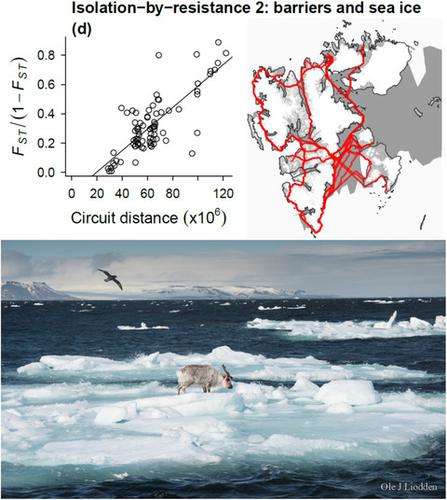当前位置:
X-MOL 学术
›
Glob. Change Biol.
›
论文详情
Our official English website, www.x-mol.net, welcomes your
feedback! (Note: you will need to create a separate account there.)
Sea ice loss increases genetic isolation in a high Arctic ungulate metapopulation.
Global Change Biology ( IF 10.8 ) Pub Date : 2019-12-17 , DOI: 10.1111/gcb.14965 Bart Peeters 1 , Mathilde Le Moullec 1 , Joost A M Raeymaekers 2 , Jonatan F Marquez 1 , Knut H Røed 3 , Åshild Ø Pedersen 4 , Vebjørn Veiberg 5 , Leif Egil Loe 6 , Brage B Hansen 1
Global Change Biology ( IF 10.8 ) Pub Date : 2019-12-17 , DOI: 10.1111/gcb.14965 Bart Peeters 1 , Mathilde Le Moullec 1 , Joost A M Raeymaekers 2 , Jonatan F Marquez 1 , Knut H Røed 3 , Åshild Ø Pedersen 4 , Vebjørn Veiberg 5 , Leif Egil Loe 6 , Brage B Hansen 1
Affiliation

|
Sea ice loss may have dramatic consequences for population connectivity, extinction-colonization dynamics, and even the persistence of Arctic species subject to climate change. This is of particular concern in face of additional anthropogenic stressors, such as overexploitation. In this study, we assess the population-genetic implications of diminishing sea ice cover in the endemic, high Arctic Svalbard reindeer (Rangifer tarandus platyrhynchus) by analyzing the interactive effects of landscape barriers and reintroductions (following harvest-induced extirpations) on their metapopulation genetic structure. We genotyped 411 wild reindeer from 25 sampling sites throughout the entire subspecies' range at 19 microsatellite loci. Bayesian clustering analysis showed a genetic structure composed of eight populations, of which two were admixed. Overall population genetic differentiation was high (mean FST = 0.21). Genetic diversity was low (allelic richness [AR] = 2.07-2.58; observed heterozygosity = 0.23-0.43) and declined toward the outer distribution range, where populations showed significant levels of inbreeding. Coalescent estimates of effective population sizes and migration rates revealed strong evolutionary source-sink dynamics with the central population as the main source. The population genetic structure was best explained by a landscape genetics model combining strong isolation by glaciers and open water, and high connectivity by dispersal across winter sea ice. However, the observed patterns of natural isolation were strongly modified by the signature of past harvest-induced extirpations, subsequent reintroductions, and recent lack of sea ice. These results suggest that past and current anthropogenic drivers of metapopulation dynamics may have interactive effects on large-scale ecological and evolutionary processes. Continued loss of sea ice as a dispersal corridor within and between island systems is expected to increase the genetic isolation of populations, and thus threaten the evolutionary potential and persistence of Arctic wildlife.
中文翻译:

海冰流失增加了北极有蹄类高种群的遗传隔离。
海冰损失可能对人口连通性、灭绝-殖民化动态,甚至受气候变化影响的北极物种的持续存在产生巨大影响。面对额外的人为压力因素,例如过度开发,这一点尤其令人担忧。在这项研究中,我们通过分析景观障碍和重新引入(收获引起的灭绝后)对其种群遗传的相互作用影响,评估了地方性高北极斯瓦尔巴德驯鹿(Rangifer tarandus platyrhynchus)海冰覆盖减少的种群遗传影响结构体。我们在 19 个微卫星位点的整个亚种范围内的 25 个采样点对 411 头野生驯鹿进行了基因分型。贝叶斯聚类分析显示由八个种群组成的遗传结构,其中两个是混合的。总体种群遗传分化较高(平均 FST = 0.21)。遗传多样性较低(等位基因丰富度 [AR] = 2.07-2.58;观察到的杂合性 = 0.23-0.43)并向外部分布范围下降,其中种群显示出显着的近亲繁殖水平。有效种群规模和迁移率的联合估计揭示了以中心种群为主要来源的强大的进化源汇动态。种群遗传结构最好用景观遗传学模型来解释,该模型结合了冰川和开阔水域的强烈隔离,以及冬季海冰扩散带来的高度连通性。然而,观察到的自然隔离模式因过去收获引起的灭绝、随后的重新引入和最近缺乏海冰的特征而发生了强烈变化。这些结果表明,过去和现在的集合种群动态的人为驱动因素可能对大规模生态和进化过程产生相互作用。作为岛屿系统内部和之间的传播走廊的海冰持续消失预计会增加种群的遗传隔离,从而威胁到北极野生动物的进化潜力和持久性。
更新日期:2020-01-22
中文翻译:

海冰流失增加了北极有蹄类高种群的遗传隔离。
海冰损失可能对人口连通性、灭绝-殖民化动态,甚至受气候变化影响的北极物种的持续存在产生巨大影响。面对额外的人为压力因素,例如过度开发,这一点尤其令人担忧。在这项研究中,我们通过分析景观障碍和重新引入(收获引起的灭绝后)对其种群遗传的相互作用影响,评估了地方性高北极斯瓦尔巴德驯鹿(Rangifer tarandus platyrhynchus)海冰覆盖减少的种群遗传影响结构体。我们在 19 个微卫星位点的整个亚种范围内的 25 个采样点对 411 头野生驯鹿进行了基因分型。贝叶斯聚类分析显示由八个种群组成的遗传结构,其中两个是混合的。总体种群遗传分化较高(平均 FST = 0.21)。遗传多样性较低(等位基因丰富度 [AR] = 2.07-2.58;观察到的杂合性 = 0.23-0.43)并向外部分布范围下降,其中种群显示出显着的近亲繁殖水平。有效种群规模和迁移率的联合估计揭示了以中心种群为主要来源的强大的进化源汇动态。种群遗传结构最好用景观遗传学模型来解释,该模型结合了冰川和开阔水域的强烈隔离,以及冬季海冰扩散带来的高度连通性。然而,观察到的自然隔离模式因过去收获引起的灭绝、随后的重新引入和最近缺乏海冰的特征而发生了强烈变化。这些结果表明,过去和现在的集合种群动态的人为驱动因素可能对大规模生态和进化过程产生相互作用。作为岛屿系统内部和之间的传播走廊的海冰持续消失预计会增加种群的遗传隔离,从而威胁到北极野生动物的进化潜力和持久性。









































 京公网安备 11010802027423号
京公网安备 11010802027423号